Turkish Air Force
The Turkish Air Force (Turkish: Türk Hava Kuvvetleri) is the aerial warfare service branch of the Turkish Armed Forces. The Turkish Air Force can trace its origins back to June 1911 when it was founded by the Ottoman Empire,[8] however, the air force as it is known today did not come into existence until 1923 with the creation of the Republic of Turkey.[9]
| Turkish Air Force | |
|---|---|
| Türk Hava Kuvvetleri | |
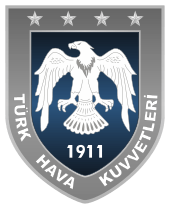 | |
| Founded | |
| Country | |
| Type | Air force |
| Role | Aerial warfare |
| Size | 60,000 personnel 1,055 aircraft [5] |
| Part of | Turkish Armed Forces |
| Headquarters | Ankara |
| Colors | Grey, White & Blue |
| March | Turkish Air Force March |
| Anniversaries | June 1[6] |
| Engagements | List of conflicts involving Turkey
|
| Website | hvkk.tsk.tr/ |
| Commanders | |
| Commander-in-Chief | President Recep Tayyip Erdoğan |
| Minister of National Defence | Minister Hulusi Akar |
| Chief of the General Staff | General Yaşar Güler |
| Commander | General Hasan Küçükakyüz |
| Vice Commander | Lt. General Turgut Atman |
| Chief of Staff | Lt. General İsmail Güneykaya |
| Insignia | |
| Roundel |  |
| Fin flash |  |
| Pilot's wings | |
| Flag of Turkish Air Force Command | 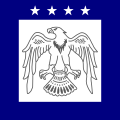 |
| Aircraft flown | |
| Attack | Anka-S, TB2, MQ-1 |
| Bomber | F-4E |
| Electronic warfare | ATR 72, B-737 |
| Fighter | F-16C/D |
| Reconnaissance | Baykuş, Gözcü, Heron, IHA-X2, Keklik, Malazgirt, Martı, Şimşek, TB1, Turna, Vestel Karayel |
| Trainer | F-5F, Hürkuş, SF-260, T-38, KT-1 |
| Transport | A400M, C-130, C-160, CH-47, CN-235, KC-135 |
 |
| Components |
|---|
| History |
| Equipment |
|
| Branches |
|---|
| History |
| Special forces |
| Member of |
| Current overseas deployments and missions[7] |
|
In 1998, the Turkish Armed Forces announced a program of modernization worth US$160 billion over a twenty-year period in various projects.[10] $45 billion was earmarked to go to the overhaul of the Turkish Air Force, and includes commissioning new combat aircraft (consisting of TAI TFX and Lockheed Martin F-35 Lightning II) and helicopters (consisting of heavy lift, attack, medium lift and light general purpose helicopters).
According to Flight International (Flightglobal.com) and the International Institute for Strategic Studies, the Turkish Air Force has an active strength of 60,000 military personnel and operates approximately 1,067 manned aircraft (2019). The Turkish Air Force's capacity has been reduced since the purges that followed the 2016 Turkish coup attempt, which saw large-scale dismissals of pilots viewed by Turkey's Islamist government as disloyal.[11][12][13][14]
The world's first black pilot Ahmet Ali Çelikten and first female fighter pilot Sabiha Gökçen both served in the TAF.[15][16][17]
History
Initial stages
The history of Ottoman military aviation dates back to between June 1909 and July 1911.[18] The Ottoman flight squadrons participated in the Balkan Wars (1912–1913) and World War I (1914–1918).[2][19] The fleet size reached its apex in December 1916, when the Ottoman aviation had 90 active combat aircraft. Some early help for the Ottoman Air Force came from the Imperial German Fliegertruppe (known by that name before October 1916), with future Central Powers 13-victory flying ace Hans-Joachim Buddecke flying with the Turks early in World War I as just one example.[20] The General Inspectorate of Air Forces (Kuva-yı Havaiye Müfettiş-i Umumiliği) trying to reconstruct itself on July 29, 1918 had no personnel, but only remained as a title on paper.[2]
After the end of World War I and the occupation of the Ottoman Empire by the Allies in 1919, some Turkish aviators tried to build new units in Istanbul, İzmir, Konya, Elazığ and Diyarbakır with planes left over from World War I and tried to bring together flight personnel.[2] During the Turkish War of Independence, Turkish pilots joined the Konya Air Station (Konya Hava İstasyonu). With the formation of the Grand National Assembly (GNA) by Mustafa Kemal and his colleagues on April 23, 1920, in Ankara, and the reorganization of the army, the Branch of Air Forces (Kuva-yı Havaiye Şubesi) was established under the Office of War (Harbiye Dairesi) of the GNA.[2] A few damaged aircraft belonging to the GNA were repaired, and afterwards used in combat.
On 1 February 1921, the Branch of Air Forces was renamed as the General Directorate of Air Forces (Kuva-yı Havaiye Müdüriyet-i Umûmiyesi) at Eskişehir and on 5 July 1922 reorganized as the Inspectorate of Air Forces (Kuva-yı Havaiye Müfettişliği) at Konya.[2][21]
Inspectorate of Air Forces
After the proclamation of independence and sovereignty with the Treaty of Lausanne and the establishment of the Republic of Turkey on 29 October 1923, approaches were made to form a modern Air Force. Originally consisting of 3 normal and 1 naval aviation units, and an air school, the number of units was increased to 10 normal and 3 naval aviation units.[22] Starting in 1924, personnel were sent abroad for flight education.[22] In 1925 the Air School was reestablished in Eskişehir and its first students graduated in that same year.[22] The Inspectorate of Air Forces was reorganized as Undersecretariat of the Ministry of Defense in 1928 and new schools were found for non-pilot personnel.[22] Some personnel were sent to the United Kingdom and France for training; others were sent to the United States and Italy in 1930.[22]
On July 1, 1932, air regiments were considered to be a separate combat arm and started training its own personnel.[22] The Turkish aviators began to wear blue uniforms from 1933.[22]
Sabiha Gökçen became the first female fighter pilot in military history in 1937.[23] Another key event in 1937 was the establishment of the Air War College (Hava Harp Akademisi).[22]
Air Force Command
By 1940, Turkish air brigades had more than 500 combat aircraft in its inventory, becoming the largest air force in the Balkans and the Middle East.[22] The growing inventory of air brigades required another structural change, which was made in 1940.[22] The Air Undersecretariat under the Ministry of National Defense for logistical affairs and the General Staff for educational affairs were united to form the Air Force Command (Hava Kuvvetleri Komutanlığı) in 1944.[22] Thus, the Air Force became a separate branch of the Turkish Armed Forces.[24] The first Commander of the Turkish Air Force was General Zeki Doğan.[24] Turkey did not enter World War II on the side of the Allies until February 1945. However, the Turkish Armed Forces went on full alert and were prepared for war following the military alliance between neighbouring Bulgaria and the Axis Powers which was formalized in March 1941, and the occupation of neighbouring Greece by the Axis Powers in April 1941. Within a year, Turkey's borders were surrounded by German forces in the northwest and west, and Italian forces in the southwest. The Turkish Air Force made daily reconnaissance flights over Bulgaria, Greece, the Greek Islands in the Aegean Sea, and the Dodecanese Islands which then belonged to Italy, to monitor the positions of the Axis forces. The large cities in western Turkey were darkened at nights, and anti-aircraft guns and searchlights were deployed for defence against possible enemy planes. Almost all available money in the Turkish Government Treasury was used to purchase new weapons from any available provider in the world. The Turkish Air Force received large numbers of new aircraft in this period, including Supermarine Spitfire Mk.I/V/IX/XIX, Curtiss Falcon CW-22R/B, Fairey Battle-I, Avro Anson-I, Hawker Hurricane I/II, Morane-Saulnier M.S.406, Curtiss P-40 Tomahawk, Curtiss P-40 Kittyhawk, Westland Lysander-I, Consolidated B-24D Liberator B-24, Bristol Blenheim IV/V, Bristol Beaufort, Bristol Beaufighter Mk.I/X, Focke-Wulf Fw 190-A3, Martin 187 Baltimore, De Havilland DH.98 Mosquito Mk.III/IV, Douglas B-26B/C Invader, P-47D Thunderbolt and Douglas C-47A/B Dakota.
The Air Machinist School (Hava Makinist Okulu) was reorganized as Aircraft Maintenance School (Hava Uçak Bakım Okulu) on 2 January 1950[25] to unite schools responsible for training non-pilot Air Force personnel.[24] In 1950 it also was decided to upgrade the Air Force fleet through the inclusion of jets.[24] Eight pilots were sent to the United States for jet pilot training.[24] They graduated in 1951 and started training jet pilots in the Turkish Air Force.[24] In the same year, the 9th Fighter Wing (9uncu Ana Jet Üssü) was founded in Balıkesir as Turkey's first fighter wing; the 191st, 192nd, and 193rd squadrons being the first ones which were established.[24] Further training in the United States followed, usually involving jet manufacturers. In 1951 the Air Force Academy was formed with integrating some air schools in Eskişehir and its first academic year started on 1 October 1951.[26] In 1956 the Hava Eğitim Kolordu Komutanlığı (Air Education Corps Command) was founded and all education was united under this command. The command was renamed as Hava Eğitim Komutanlığı (Air Education Command) in 1957.[24]
Upon Turkey's membership to NATO in 1952, the process of modernization was accelerated.[24] In 1962 the Taktik Hava Kuvveti (Tactical Air Force) was founded by upgrading the Hava Tümeni (Air Division) units to corps-level organizations. In 1974 the Air Force was employed in the Cyprus War.[24] With the arrival of 3rd generation fighter jets in 1980, the Air Force was reorganized.[24]
Turkish Air Force and NATO
The headquarters of NATO's Allied Air Component Command for Southern Europe (formerly designated as AIRSOUTH and originally headquartered in Naples, Italy) was established in İzmir, Turkey, on 11 August 2004. Allied Air Command İzmir was deactivated on 1 June 2013, when the Allied Air Command (AIRCOM) at the Ramstein Air Base in Germany became the sole Allied Air Component Command of NATO.[27]
Turkey is one of five NATO member states which are part of the nuclear sharing policy of the alliance, together with Belgium, Germany, Italy, and the Netherlands.[28] A total of 90 B61 nuclear bombs are hosted at the Incirlik Air Base, 40 of which are allocated for use by the Turkish Air Force in case of a nuclear conflict, but their use requires the approval of NATO.[29] As of 2010, the United States is considering withdrawing these nuclear bombs from Turkey, and from several other foreign locations in Europe.[30]
Aftermath of 2016 coup attempt
In the aftermath of the 2016 Turkish coup attempt, thousands of military officers were dismissed, with many arrested and jailed.[31] As Air Force pilots had played a major role in the coup attempt (the headquarters of the coup attempt was at the Akinci base near the capital Ankara), more than 350 F-16 pilots were also jailed, leaving the Air Force with more airplanes than pilots.[32] In response, the Turkish government has sought to compel retired pilots to return to the military and to strengthen its air defence systems.[33] A former head of the Air Force was dismissed, as well as 42% of Air Force generals and several base commanders, including the commander of the important Incirlik Air Base.[34]
Notable events
- In 1925, the Air Force was deployed to take part in campaign aimed to suppress the Sheikh Said rebellion.[35]
- Sabiha Gökçen was the first Turkish female combat pilot. She joined the Turkish Air Force in 1936 and in 1937 took part in the military operation to put down the Dersim Revolt, thus becoming the world's first female air force pilot with battle experience. Throughout her career in the Turkish Air Force, which lasted until 1964, Gökçen flew 22 different types of aircraft for more than 8000 hours, 32 of which were active combat and bombardment missions.[36] She was selected as the only female pilot for the poster of "The 20 Greatest Aviators in History" published by the United States Air Force in 1996.[36]
- In 1995, the Turkish Air Force took part in NATO's Operation Deliberate Force.
- Turkey provided 18 F-16s for the NATO campaign against Serbia during Operation Allied Force in 1999. Of these, 11 TAI-built F-16s were stationed at the NATO base in Aviano, Italy, while the other 7 were based in Ankara, Turkey. All were equipped with laser-guided bombs using the LANTIRN night vision system. Turkish jets had previously patrolled Balkan airspace, providing protection for attacking aircraft. During this allied air campaign, TAI-built F-16s set a world CAP record by patrolling for 9 hours and 22 minutes above the Balkan theatre. Normally, CAP missions last between 3 and 4 hours.
- On 8 October 1996 – 7 months after the escalation of the dispute with Turkey over the Imia/Kardak islands, a Greek Mirage 2000 fired an R.550 Magic II missile and shot down a Turkish F-16D[37] over the Aegean Sea. The Turkish pilot died, while the co-pilot ejected and was rescued by Greek forces.[38] In August 2012, after the downing of a RF-4E on the Syrian Coast, Turkish Defence Minister İsmet Yılmaz confirmed that the Turkish F-16D was shot down by a Greek Mirage 2000 with an R.550 Magic II in 1996 after reportedly violating Greek airspace near Chios island.[39] Greece denies that the F-16 was shot down.[40] Both Mirage 2000 pilots reported that the F-16 caught fire and they saw one parachute.[41]
- Turkey participated in the United Nations peacekeeping mission in Bosnia-Herzegovina, employing two squadrons (one in the Ghedi fighter wing, and after 2000 one in the Aviano fighter wing).[24] They returned to Turkey in 2001.
- In 2006, 4 Turkish F-16 fighter jets were deployed for NATO's Baltic Air Policing operation.
- In December 2007, the Turkish Air Force initiated Operation Northern Iraq, which continued until the end of February 2008, eventually becoming a part of Operation Sun. At the initial phase of this operation, on December 16, 2007, the TuAF used the AGM-65 Maverick and AGM-142 Popeye/Have Nap during a night bombardment for the first time.
- On 22 June 2012, a Turkish RF-4E Phantom II reconnaissance aircraft was lost, reportedly due to Syrian anti-aircraft fire. The incident happened over the Mediterranean Sea, close to the town of Ras al-Bassit.[42]
- On September 16, 2013, Turkish jets shot down a Syrian Mi-17 helicopter on the Syrian-Turkish border.[43]
- On 23 March 2014, Turkish fighter jets shot down a Syrian MiG-23. The Syrian Arab Republic claims that its aircraft was in Syrian airspace on a mission to attack rebel held areas in the city of Latakia when it was shot down by Turkey in an act of "blatant aggression." The Syrian pilot successfully ejected from the aircraft.[44] Turkish Prime Minister Erdoğan stated that Turkish F-16s shot down the aircraft for violating Turkish airspace and said that the Turkish "response will be heavy if you violate our airspace."[45]
- On 24 November 2015, a Turkish F-16 shot down a Russian Su-24 Fencer strike aircraft which, according to Turkish authorities, had violated its airspace. The Russian Government contests those claims, stating that the aircraft never entered Turkish airspace. One Russian pilot was killed, the other rescued in a Russian special forces operation.[46][47]
- Following a failed coup attempt in 2016 and subsequent purges, more than 300 pilots were dismissed from the air force, including the pilot that shot down the Su-24 Fencer a year earlier.[48] This resulted in the TAF struggling to keep it's F-16 fleet combat ready. The Turkish government started looking overseas to make up the shortfall.[49]
Equipment
Fighter and reconnaissance aircraft
In 1984 Turkish Aerospace Industries (TAI) was established and Turkey started to produce fighter aircraft locally under license, including a total of 232 F-16 Fighting Falcon (Block 30/40/50) aircraft for the air force. The air force had previously received 8 F-16s that were purchased directly from the United States, bringing the total number of F-16s received by the air force to 240.[50] TAI is currently building 30 new F-16 Block 50+ aircraft for the TuAF[51][52] and is applying a CCIP upgrade on the existing fleet of Block 30/40/50 F-16s, which will bring all of them to the Block 50+ standard.[50][53][54][55] Dozens of TAI-built F-16s were also exported to other countries, particularly in the Middle East. A total of 46 TAI-built F-16s have been exported to the Egyptian Air Force under the Peace Vector IV Program (1993–1995), making it TAI's second-largest F-16 customer after the Turkish Air Force.[56] Turkey is one of only five countries in the world which locally produce the F-16 Fighting Falcon.[50]
Turkey placed an order for 30 F-35 Lightning II's with four delivered to Luke Air Force Base, and then had the order cancelled due to the country's acquisition of the S-400 SAM systems from Russia.[57][58]
Airborne early warning and control (AEW&C) aircraft
A total of four Boeing 737 AEW&C Peace Eagle (Turkish: Barış Kartalı) aircraft (together with ground support systems) were ordered by the Turkish Air Force, with an option for two more aircraft. Turkish Aerospace Industries (TAI) is the primary subcontractor for the Peace Eagle parts production, aircraft modification, assembly and tests. Another subcontractor, Havelsan, is responsible for system analysis and software support.[59]
Signed on 23 July 2003, the contract to Boeing valued at US$1.385 billion, which was later reduced by US$59 million because some of the requirements were not met. The down payment to Boeing amounted to US$637 million. The project consists of the delivery of 737-700 airframes, ground radars and control systems, ground control segments for mission crew training, mission support and maintenance support.[60]
Peace Eagle 1 is modified and tested by Boeing Integrated Defense Systems in Seattle, Washington, USA. Peace Eagle 2, 3 and 4 are modified and tested at the facilities of TAI in Ankara, Turkey, with the participation of Boeing and a number of Turkish companies. As of 2006, the four Peace Eagle airplanes were scheduled to be delivered in 2008.[61] As of mid-2007, systems integration was ongoing and airworthiness certification works continued. In September 2007, Boeing completed the first test flight of Turkey's AEW&C 737.[62]
On 4 June 2008, it was announced that Turkish Aerospace Industries completed the first in-country modification of a Boeing 737-700 into an airborne early warning and control (AEW&C) platform for Turkey's Peace Eagle program.[63]
The first Peace Eagle aircraft, named Kuzey (meaning North) was formally accepted into Turkish Air Force inventory on 21 February 2014.[64][65][66][67] The remaining three aircraft will be named Güney (South), Doğu (East) and Batı (West).[67]
The six-year delay was a result of Boeing experiencing difficulties while developing some features required by the Turkish Air Force. Turkey demanded compensation of US$183 million from Boeing for the delay. The payment of the penalty is requested in the form of increased start-up support period from an initially planned two years to five years, as well as three years of software maintenance service and around US$32 million in spare parts.[60]
Aerial refueling tanker aircraft
_of_the_Turkish_Air_Force_arrives_2016_RIAT_7Jul2016_arp.jpg)
In 1994 the Turkish Air Force signed a deal to lease two and purchase seven Boeing KC-135R Stratotanker aerial refueling tanker aircraft.[68] Following the arrival of all seven purchased aircraft, the two leased KC-135Rs were returned to the United States.[68] All seven KC-135R Stratotanker aircraft of the Turkish Air Force have received the Pacer CRAG (Compass, Radar And GPS) upgrade. The KC-135R-CRAG Stratotanker aerial refueling tanker aircraft of the Turkish Air Force are operated by the 101st Squadron, stationed at the Incirlik Air Base.[68]
Military transport aircraft
Turkey is a partner nation in the Airbus A400M Atlas production program. The Turkish Air Force has ordered a total of ten A400M Atlas aircraft.[69] The first two A400M Atlas were delivered to the Turkish Air Force in 2014.[70][71][72] All A400M Atlas deliveries to the Turkish Air Force are scheduled to be completed by 2018.[73][74] Turkish Aerospace Industries (TAI) produces several components of the A400M Atlas, including the middle-front fuselage, emergency exit doors, rear fuselage upper panels, rear upper escape doors, ailerons and spoilers; which are sent to the Airbus Military factory in Spain for assembly.[75]
Although the Airbus A400M Atlas is essentially a heavy tactical lift aircraft, it can also be transformed into an aerial refueling tanker aircraft at short notice.
The Turkish Air Force also uses the CASA CN-235, C-130 Hercules and C-160 Transall military transport aircraft.
Unmanned aerial vehicles (UAV)
At present, the Turkish Air Force operates MALE UAVs such as the TAI Anka, Bayraktar Tactical UAS, IAI Heron and the I-GNAT ER. Having been unable to purchase the armed version of Predator UCAVs from the United States, Turkey plans to produce armed UCAV versions of TAI Anka (to be fitted with missiles such as the AGM-114 Hellfire and Roketsan Cirit); while TAI has become the leading partner in the Talarion UCAV project of EADS.[76][77][78]
Satellites
Turkish Air Force operate an intelligence satellite named Göktürk-2, with plans to commission more in years ahead. These include a 0.8m resolution reconnaissance satellite (Project Göktürk-1) for use by the Turkish Armed Forces and a 2m resolution reconnaissance satellite (Project Göktürk-2) for use by the National Intelligence Organization. The production of Göktürk-2 is completed by the Turkish Aerospace Industries, while Göktürk-1 is still in the production stage. Some electro-optical parts that are required for the Göktürk-1 (0.8m resolution) satellite were beyond TAI's technological know-how, thus a foreign partner was sought. The official bidders for the project were EADS Astrium (U.K.), OHB-System (Germany) and Telespazio (Italy);[79] and the contract was won by Telespazio of Italy.[80]
Göktürk-2 was launched from Jiuquan Launch Area 4 / SLS-2 in China by a Long March 2D space launch vehicle at 16:12:52 UTC on December 18, 2012. It was placed into a low Earth orbit of 686 km (426 mi) at 16:26 UTC. The first signal from Göktürk-2 was received at 17:39 UTC by the Tromsø Satellite Station, northern Norway.
In 2013 Turkey approved the construction by ROKETSAN of its first satellite launching center, initially for low earth orbit satellites.[81]
In 2015, Ukraine and Turkey agreed on space program which worth billions of dollars.[82]
Formation and structure
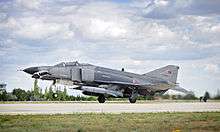
.jpg)
Mockup_Teknofest2019_(1).jpg)
For a long period of time the combat units of the Turkish Air Force were organized into a 1st Air Force (deployed in the western part of the country and headquartered in Eskişehir) and a 2nd Air Force (deployed in the eastern part of the country and headquartered in Diyarbakır). On August 5, 2014 the two have been fused into the newly formed Combatant Air Force and Air Defence Command with headquarters in Eskişehir.[83] After the 2016 Turkish coup d'état attempt and because of its involvement in it the 4th Main Jet Air Base Command near Ankara has been disbanded in disgrace and its F-16 dispersed to other bases.
Commands
- AIR FORCE COMMAND HQ (Hava Kuvvetleri Komutanlığı Karargâhı) (Ankara)
- Chief of the Turkish General Staff: General Yaşar Güler
- Commander of the Turkish Air Force: General Abidin Ünal
- Combatant Air Force and Air Missile Defense Command (Muharip Hava Kuvveti ve Hava Füze Savunma Komutanlığı) (Eskişehir)
- 1st Main Jet Base Command (1. Ana Jet Üs Komutanlığı) (Eskişehir)
- 111th Squadron "Panther" (111. Filo "Panter") - F-4E 2020T Terminator (last operational F-4 unit)
- 112th Squadron "Devil" (112. Filo "Şeytan") (temporarily disbanded in anticipation of F-35As[84])
- 113th Squadron "Gazelle" (113. Filo "Ceylan") - F-16C/D Block 50/50+ Fighting Falcon (SNIPER and DB.110 recon pods-specialised. The former 113th Squadron "Light" ("Işık") flying RF-4E has been disbanded in 2014,[85] but the disbandment of the 4th Main Jet Base in Ankara-Akıncı has resulted in the relocation and rebadging of its reconnaissance 142nd Squadron "Gazelle" (142. Filo Ceylan) to Eskişehir[86])
- 401st Test Squadron (401. Test Filosu) - F-16C/D Block 30/40, F-4E 2020 (weapons testing and evaluation squadron, took over this role from the 132nd Squadron[87])
- 201st Liaison and SAR Squadron "Attack" (201. İrtibat ve Arama-Kurtarma Filosu "Atak") - CN-235M-100, AS-532UL Mk.1
- 3rd Main Jet Base Command (3. Ana Jet Üs Komutanlığı) (Konya)
- 131st Squadron "Dragon" (131. Filo "Ejder") - B-737-7ES AEW&C (AEW squadron)
- 132nd Squadron "Dagger" (132. Filo "Hançer") - F-16C/D Block 50 Fighting Falcon (in 2014 the unit has been designated as a weapons and tactics training squadron.[88] However, after the 2016 restructuring of the TuAF units this might has changed, as the Turkish DHA news agency has reported, that 12 F-16s of the squadron have participated in bombing missions in Northern Syria as part of Operation Olive Branch in January 2018.[89])
- 133rd Aerobatic Squadron "Turkish Stars" (133. Akrotim Filo "Türk Yıldızları") - NF-5A/B 2000 Freedom Fighter
- 135th Liaison and SAR Squadron "Fire" (135. İrtibat ve Arama-Kurtarma Filosu "Ateş") - AS-532UL Mk.1+
- 5th Main Jet Base Command (5. Ana Jet Üs Komutanlığı) (Merzifon)
- 151st Squadron "Bronze" (151. Filo "Tunç") - F-16C/D Block 50 Fighting Falcon (HARM-specialised)
- 152nd Squadron "Raider" (152. Filo "Akıncı") - F-16C/D Block 50 Fighting Falcon (relocated to Incirlik Air Base to free facilities at Merzifon for the relocation of 4th Main Jet Base's 143rd Squadron from Ankara-Akıncı, but retained as part of 5th Main Jet Base Command)
- 153rd Squadron "Forefather" (153. Filo "Öncel") - F-16C/D Block 30/40 Fighting Falcon (F-16 OCU, the former 4th Main Jet Base's (in Ankara-Akıncı) 143rd Squadron in the OCU role, relocated to Merzifon and rebadged as the 153rd.)
- 5th Main Jet Base Command SAR Flight "Angel" (5. Ana Jet Üs Komutanlığı Arama-Kurtarma Kolu "Melek") - AS-532UL Mk.1+
- 6th Main Jet Base Command (6. Ana Jet Üs Komutanlığı) (Bandırma)
- 161st Squadron "Bat" (161. Filo "Yarasa") - F-16C/D Block 40/50+ Fighting Falcon (LANTIRN-specialised)
- 162nd Squadron "Harpoon" (162. Filo "Zıpkın") - F-16C/D Block 40 Fighting Falcon
- 6th Main Jet Base Command SAR Flight (6. Ana Jet Üs Komutanlığı Arama-Kurtarma Kolu) - AS-532UL Mk.1+
- 7th Main Jet Base Command (7. Ana Jet Üs Komutanlığı) (Malatya-Erhaç)[90]
- 171st Squadron "Corsair" (171. Filo "Korsan") (temporarily disbanded, to convert to F-35A)
- 172nd Squadron "Hawk" (172. Filo "Şahin") (temporarily disbanded, to convert to F-35A)
- 173rd Squadron "Dawn" (173. Filo "Şafak") (recon squadron, RF-4E/TM(G) phased out of service, to operate armed TAI Anka UAVs)
- 7th Main Jet Base Command SAR Flight "Burak" (7. Ana Jet Üs Komutanlığı Arama-Kurtarma Kolu "Burak") - AS-532UL Mk.1+
- 8th Main Jet Base Group Command (8. Ana Jet Üs Komutanlığı) (Diyarbakır)
- 181st Squadron "Leopard" (181. Filo "Pars") - F-16C/D Block 40TM/Block 50+ Fighting Falcon (LANTIRN-specialised)
- 182nd Squadron "Accipiter" (182. Filo "Atmaca") - F-16C/D Block 40 Fighting Falcon
- 202nd Liaison and SAR Squadron "East" (202. İrtibat ve Arama-Kurtarma Filosu "Şark") - CN-235M-100, AS-532UL Mk.1+
- 9th Main Jet Base Command (9. Ana Jet Üs Komutanlığı) (Balıkesir)
- 191st Squadron "Cobra" (191. Filo "Kobra") - F-16C/D Block 50 Fighting Falcon
- 192nd Squadron "Tiger" (192. Filo "Kaplan") - F-16C/D Block 50 Fighting Falcon
- 9th Main Jet Base Command SAR Flight (9. Ana Jet Üs Komutanlığı Arama-Kurtarma Kolu) - AS-532UL Cougar Mk.1+
- 10th Tanker Base Command (10. Tanker Üs Komutanlığı) (Incirlik)
- 101st Tanker Squadron "Asena" (101. Tanker Filosu "Asena") - KC-135R Stratotanker
- 14th UAV Systems Base Command (14. İnsansız Uçak Sistemleri Üs Komutanlığı) (Batman)
- TAI Anka, IAI Heron, Karayel, Harpy, I-GNAT ER
- Air Defence Command (Hava Savunma Komutanlığı)
- 15th Missile Base Command (15. Füze Üs Komutanlığı) (Alemdağ-Istanbul)
- S400 Group Command (S400 Grup Komutanlığı) (Akıncı-Ankara)[91]
- 9 x Aerial Surveillance Radar Post Commands (Ahlatlıbel-Ankara; Körfez-Kocaeli; Karabelen-Izmir; Çanakkale; Erzurum; Datça-Muğla; Ayancık-Sinop; İskenderun-Hatay; Rize)
- 13 x Airfield Commands (reserve air bases) (Akhisar, Antalya, Batman, Dalaman, Erzurum, Afyon, Çorlu, Muş, Ağrı, Sivas, Sivrihisar, Van, Yalova)
- after the 2016 Turkish coup d'état attempt the 4th Main Jet Base Command in Akıncı-Ankara has been disbanded and demoted to an airfield command status
- 1st Main Jet Base Command (1. Ana Jet Üs Komutanlığı) (Eskişehir)
- Air Training Command (Hava Eğitim Komutanlığı) (İzmir)
- 2nd Main Jet Base Command (2. Ana Jet Üs Komutanlığı) (Çiğli-İzmir)
- 121st Squadron "Bee" (121. Filo "Arı") - T-38A Talon (advanced flying training)
- 122nd Squadron "Scorpion" (122. Filo "Akrep") - KT-1T (basic flying training)
- 123rd Squadron "Chick" (123. Filo "Palaz") - SF-260D ((initial flying training)
- 124th Squadron "Pioneer" (124. Filo "Öncü") (borrows a/c from the other squadrons) (instructor training, standartidation and instrumental flying training)
- 125th Squadron "Panther" (125. Filo "Panter") - CN-235M-100, UH-1H Iroquois (transport and helicopter training)
- Air Training Command Liaison Squadron (Hava Eğitim Komutanlığı İrtibat Filosu) (İzmir-Adnan Menderes Airport)
- 203rd SAR Squadron "Aegean" (203. Arama Kurtarma Filosu "Ege") - CN-235M-100
- Air Warfare School (Hava Harp Okulu, the Air Force academy) (Yeşilköy-Istanbul)
- Training Corps (Eğitim Kıtaatı)
- Sparrow Flight (Serçe Kol) - T-41D Mescalero
- Search and Rescue Flight (Arama-Kurtarma Kolu) - UH-1H Iroquois
- Yalova Glider Camp (Yalova Planör Kampı) - SZD-50-3
- Training Corps (Eğitim Kıtaatı)
- Air Force Technical Schools Command (Hava Teknik Okullar Komutanlığı) (Gaziemir Air Base, İzmir)
- Air Force NCO Schools Command (Hava Sınıf Okulları Komutanlığı) (Gaziemir Air Base, İzmir)
- Air Force Basic Training Brigade Command (Hava Er Eğitim Tugay Komutanlığı) (Kütahya)
- 2nd Main Jet Base Command (2. Ana Jet Üs Komutanlığı) (Çiğli-İzmir)
- Air Logistical Command (Hava Lojistik Komutanlığı) (Etimesgut-Ankara)
- 11th Air Transportation Main Base Command (11. Hava Ulaştırma Ana Üs Komutanlığı) (Etimesgut-Ankara)
- 12th Air Transportation Main Base Command (12. Hava Ulaştırma Ana Üs Komutanlığı) (Erkilet-Kayseri)
- 221st Squadron "Breeze" (221. Filo "Esen") - A-400M, C-160D)
- 222nd Squadron "Flame" (222.Filo "Alev") - C-130B/E)
- 1st Air Supply and Maintenance Center Command (1. Hava İkmal Bakım Merkezi Komutanlığı) (Eskişehir)
- 2nd Air Supply and Maintenance Center Command (2. Hava İkmal Bakım Merkezi Komutanlığı) (Kayseri)
- 3rd Air Supply and Maintenance Center Command (3. Hava İkmal Bakım Merkezi Komutanlığı) (Ankara)
- Military Air Traffic Control Command (Hava Malzeme Transit Komutanlığı) (İstanbul)
- Air Museum Command (Hava Kuvvetleri Müzesi) (İstanbul)

Squadrons
The above commands consist of:[9]
- 19 Combat squadrons
- 1 Reconnaissance squadron
- 6 Training squadrons
- 6 Transportation squadrons
- 1 Tanker squadron
- 8 Surface-to-air missile (SAM) squadrons
Insignia
| NATO code | OF-10 | OF-9 | OF-8 | OF-7 | OF-6 | OF-5 | OF-4 | OF-3 | OF-2 | OF-1 | OF(D) | Student officer | ||||||||||||||||||||||||
|---|---|---|---|---|---|---|---|---|---|---|---|---|---|---|---|---|---|---|---|---|---|---|---|---|---|---|---|---|---|---|---|---|---|---|---|---|
(Edit) |
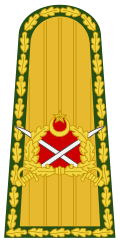 |
 |
 |
 |
 |
 |
 |
 |
 |
 |
 |
.svg.png) |
Various [note 1] | |||||||||||||||||||||||
| Mareşal | Orgeneral | Korgeneral | Tümgeneral | Tuğgeneral | Albay | Yarbay | Binbaşı | Yüzbaşı | Üsteğmen | Teğmen | Asteğmen | Harbiyeli | ||||||||||||||||||||||||
| NATO Code | OR-9 | OR-8 | OR-7 | OR-6 | OR-5 | OR-4 | OR-3 | OR-2 | OR-1 | |||||||||||||||||||||||||||
|---|---|---|---|---|---|---|---|---|---|---|---|---|---|---|---|---|---|---|---|---|---|---|---|---|---|---|---|---|---|---|---|---|---|---|---|---|
(Edit) |
 |
 |
 |
 |
 |
 |
 |
 |
 |
 |
No insignia | |||||||||||||||||||||||||
| Astsubay Kıdemli Başçavuş | Astsubay Başçavuş | Astsubay Kıdemli Üstçavuş | Astsubay Üstçavuş | Astsubay Kıdemli Çavuş | Astsubay Çavuş | Uzman Çavuş | Çavuş | Uzman Onbaşı | Onbaşı | Er | ||||||||||||||||||||||||||
- OF3, OF2, & OR2 translate to "Head of 1000", "Head of 100", and "Head of 10" respectively.
Future of the Turkish Air Force
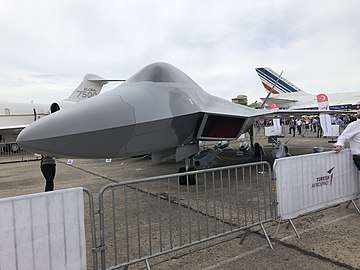
On July 11, 2002 Turkey became a Level 3 partner of the F-35 Joint Strike Fighter (JSF) development program, and on January 25, 2007, Turkey officially joined the production phase of the JSF program, agreeing to initially purchase 116 F-35A Lightning II aircraft.[95][96][97][98][99]
Turkey also has a national fifth generation fighter aircraft project named the TAI TFX.
On 28 March 2013, the Turkish Secretary of the Defence Industry of the Ministry of National Defence of Turkey Murat Bayar announced intentions to replace the F-16 fighter with domestically produced fighters by 2023.[100]
Havelsan of Turkey and Boeing of the United States are in the process of developing a next generation, high-altitude ballistic missile defence shield. It is envisaged that the system will be used by the U.S., Turkey and other NATO member states.[101][102][103]
In June 2018 the US Senate passed a defense spending bill that now prevents the Turkish Air Force from obtaining the F-35 stealth fighter. Tensions between the US and Turkey are to blame for the denied contract, and now may put Turkey in a position to become the first customer for Russia's Su-57.[104]
See also
- Turkish Stars
- List of Commanders of the Turkish Air Force
- List of Chiefs of the Turkish General Staff
Notes
- Student officer insignia denotes school grade rather than military seniority.
References
- The Turkish Air Force regards flight trainings of Captain Fesa Bey and Lieutenant Yusuf Kenan Bey in 1911 as its own start line and celebrates its 100th anniversary in 2011. "Türk Hava Kuvvetleri 100 Yaşında" in the official website of Turkish Air Force Archived 2011-06-26 at the Wayback Machine (in Turkish)
- Hv. K. K. Mebs. "1918-1923". Archived from the original on 5 May 2015. Retrieved 24 December 2014.
- "1944-1980" in the official website of the Turkish Air Force Archived 2011-04-26 at the Wayback Machine (in Turkish)
- 1949 Temmuzunda Türk Silâhlı Kuvvetleri yeniden örgütlendirilerek, Genelkurmay Başkanlığına bağlı Kara, Deniz, Hava Kuvvetleri kuruldu., Genelkurmay Başkanlığı, Türk Tarihi, Silahlı Kuvvetleri ve Atatürkçülük, Genelkurmay Başkanlığı, 1973, p. 65. (in Turkish)
- "2020 Turkey Military Strength". www.globalfirepower.com.
- "Bugün Hava Kuvvetleri'nin kuruluş yıldönümü!". Archived from the original on 2014-10-06. Retrieved 24 December 2014.
- "Türk Silahlı Kuvvetlerinin Barışı Destekleme Harekâtlarına Katkıları". tsk.tr. Retrieved 18 June 2014.
- Hv. K. K. Mebs. "The First Establishment and the Early Years". Archived from the original on 7 October 2011. Retrieved 24 December 2014.
- "Scramble on the Web: Turkish Air Force - Order of Battle". Archived from the original on October 1, 2010.
- Economist Intelligence Unit:Turkey, p.22 (2005)
- https://www.al-monitor.com/pulse/originals/2018/05/turkey-military-purges-career-officer-pilot.html
- https://www.reuters.com/article/us-turkey-security-airforce-idUSKBN1350ID
- https://www.businessinsider.com/r-depleted-by-coup-turkish-air-force-seeks-to-lure-back-seasoned-pilots-2016-11?IR=T
- https://nationalinterest.org/blog/buzz/turkeys-air-force-ruin-neither-russia-nor-iran-blame-115901
- Clavin, Tom; Keith, Phil (November 5, 2019). All Blood Runs Red: The Legendary Life of Eugene Bullard-Boxer, Pilot, Soldier, Spy. Harlequin. ISBN 9781488036033 – via Google Books.
- Scott, Alev (October 4, 2018). Ottoman Odyssey: Travels through a Lost Empire: Shortlisted for the Stanford Dolman Travel Book of the Year Award. Quercus. ISBN 9781784293703 – via Google Books.
- "First female combat pilot". Guinness World Records.
- "Page not found". Archived from the original on December 7, 2013.
- "Page not found". Archived from the original on June 11, 2013.
- "Page not found". Archived from the original on June 11, 2013.
- Utkan Kocatürk, Atatürk ve Türkiye Cumhuriyeti tarihi kronolojisi, 1918–1938, Türk Tarîh Kurumu Basımevi, 1983, p. 674.
- Hv. K. K. Mebs. "1923-1944". Archived from the original on 7 October 2014. Retrieved 24 December 2014.
- "The Air University 404 Page".
- Hv. K. K. Mebs. "1944-1980". Archived from the original on 7 October 2014. Retrieved 24 December 2014.
- "official website of the Air Technical Schools Command". Archived from the original on August 17, 2011.
- Mehmet Özel, 2000'li Yıllara Girerken Türk Ordusu, Kültür Bakanlığı, 2000, ISBN 978-975-17-2226-3, p. 198. (in Turkish)
- "NATO deactivates Allied Air Command Izmir". NATO. Archived from the original on 2014-07-14. Retrieved 15 June 2014.
- SPIEGEL ONLINE, Hamburg, Germany (10 April 2009). "Yankee Bombs Go Home: Foreign Minister Wants US Nukes out of Germany". SPIEGEL ONLINE. Archived from the original on 2012-02-14. Retrieved 24 December 2014.CS1 maint: multiple names: authors list (link)
- "NRDC: U.S. Nuclear Weapons in Europe • Hans M. Kristensen / Natural Resources Defense Council, 2005" (PDF). nrdc.org. Archived (PDF) from the original on 2011-01-01. Retrieved 2009-06-10.
- "Report: US considers withdrawing nuclear bombs from Turkey Archived 2014-10-15 at the Wayback Machine", Today's Zaman. April 03, 2010.
- https://www.al-monitor.com/pulse/originals/2018/05/turkey-military-purges-career-officer-pilot.html
- https://www.reuters.com/article/us-turkey-security-airforce-idUSKBN1350ID
- https://www.businessinsider.com/r-depleted-by-coup-turkish-air-force-seeks-to-lure-back-seasoned-pilots-2016-11?IR=T
- https://nationalinterest.org/blog/buzz/turkeys-air-force-ruin-neither-russia-nor-iran-blame-115901
- Olson, Robert (1989). The Emergence of Kurdish Nationalism and the Sheikh Said Rebellion, 1880–1925. University of Texas Press. p. 120. ISBN 978-0-292-76412-5.CS1 maint: date and year (link)
- "TRT World". Archived from the original on 2016-03-06. Retrieved 2012-01-11.
- "Turkish F-16 jet crashes after Greek interception", Chicago Sun-Times, High beam, 9 October 1996, archived from the original on 4 November 2012
- "91-0023", Aircraft Database (airframe details), F-16, retrieved 18 May 2008
- "Tuaf incidents". The Avionist. Sep 6, 2012.
- https://www.rt.com/news/343467-turkey-greek-pilot-sentence/ Athens also denies the downing of the jet, and says that Turkish pilot reported a control failure. It also claims that the jet violated Greece's airspace because one of the Turkish pilots was rescued in the Greek flight information region.
- https://www.businessinsider.com/turkish-and-greek-fighters-engaged-in-a-dogfight-over-the-aegean-sea-2015-12
- "BBC News - Syrian military says it downed Turkish fighter jet". BBC News. 23 June 2012. Archived from the original on 2014-10-03. Retrieved 24 December 2014.
- Tawfiq, Saif (2013-09-16). "Turkish warplanes shoot down Syrian helicopter". Reuters. Archived from the original on 2013-11-15. Retrieved 2013-11-19.
- "Turkish jet downs Syrian warplane near border". The Big Story. Archived from the original on 2014-10-31. Retrieved 4 March 2015.
- "Archived copy". Archived from the original on 2015-12-08. Retrieved 2015-12-04.CS1 maint: archived copy as title (link)
- "Is this start of a wider war?". NewsComAu. 25 November 2015. Archived from the original on 2015-11-26. Retrieved 2015-11-25.
- "How is this not World War III? - CNN.com". CNN. Archived from the original on 2015-11-25. Retrieved 2015-11-25.
- Peck, Michael. "Turkey Nearly Killed Off Its Own Air Force". Middle East Forum.
- "Turkey's air force can barely fly its F-16s - analyst". Ahval.
- "F-16.net: Turkish Air Force". Archived from the original on 2008-01-24. Retrieved 2008-02-01.
- "Turkey signs $1.78 bln deal to buy warplanes". Reuters. May 11, 2007. Archived from the original on 2009-06-08. Retrieved 2017-07-02.
- "Turkey signs contract to buy 30 F-16 block 50+ jets". F-16.net. Archived from the original on 2007-09-29. Retrieved 2007-09-07.
- "F-16 Peace Onyx III program kicks off at TAI". F16 Net. July 11, 2007. Archived from the original on 2007-09-27. Retrieved 2007-07-12.
- "$1.1B to Upgrade Turkish F-16 fleet". Defense Industry Daily. Archived from the original on 2007-02-04. Retrieved 2006-12-25.
- "Contracts". U.S. Dept of Defense. December 22, 2006. Archived from the original on 2006-12-27. Retrieved 2006-12-25.
- "Turkish Aerospace Industries: Programs". Archived from the original on 2008-02-27. Retrieved 2008-02-16.
- "Turkish F-35 delivered to training base in Arizona, official says". Reuters. 2019-04-04. Retrieved 2019-07-17.
- "Archived copy". Archived from the original on 2019-07-19. Retrieved 2019-07-19.CS1 maint: archived copy as title (link)
- Peace Eagle (PE) - Turkish Airborne Early Warning & Control System Archived 2008-08-20 at the Wayback Machine, Havelsan.
- "Turkey imposes $183 million penalty on Boeing over delivery delay". Hürriyet Daily News. 2014-02-18. Archived from the original on 2014-02-25. Retrieved 2014-02-20.
- "Boeing Installs MESA Antenna on First Peace Eagle Aircraft" Archived 2008-09-05 at the Wayback Machine, Boeing, March 2, 2006.
- "Boeing Successfully Completes First Test Flight of AEW&C Peace Eagle Aircraft" Archived 2008-01-24 at the Wayback Machine, Boeing, September 6, 2007.
- "Turkish Aerospace Industries completes modification of Peace Eagle AEW&C aircraft". Frontier India. Archived from the original on 1 October 2011. Retrieved 24 December 2014.
- BEKDIL, BURAK EGE (8 February 2014). "Boeing Delivers 1st Spy Plane To Turkey; Faces Penalties". www.defensenews.com. Gannett Government Media. Retrieved 8 February 2014.
- "TSK yeni yıldızı Barış Kartalı'na kavuştu" Archived 2015-02-22 at the Wayback Machine. Hürriyet, 21 February 2014.
- "Turkey takes delivery of military aircraft" Archived 2015-02-22 at the Wayback Machine. Today's Zaman, 21 February 2014.
- "First Airborne Early Warning & Control aircraft of the Peace Eagle Project, Kuzey (North) was taken into inventory" Archived 2014-03-11 at the Wayback Machine. Turkish Air Force
- "Boeing KC-135R "Stratotanker"". Archived from the original on 2008-04-12. Retrieved 2008-05-17.
- Bekdil, Burak Ege (24 December 2014). "Turkey Receives Second A400M". DefenseNews. Retrieved 25 November 2015.
- "Turkish air force receives second A400M". Flightglobal. Archived from the original on 2014-12-30. Retrieved 30 December 2014.
- "Airbus Defence and Space delivers A400M to Turkish Air Force". airbus-group.com. Archived from the original on 22 May 2014. Retrieved 22 May 2014.
- "Turkey Accepts First A400M" Defense news Retrieved: 11 May 2014.
- "Military cargo plane to be delivered to Turkey in 2013." Archived 2011-05-21 at the Wayback Machine Hürriyet Daily News. Retrieved: 1 July 2011.
- "Turkey accepts delivery of its First Airbus A400M". 5 April 2014. Archived from the original on 2014-12-24. Retrieved 2015-02-18.
- "TAI ships first body parts of A400M planes". TodaysZaman. Archived from the original on 25 December 2014. Retrieved 24 December 2014.
- "Turkey to manufacture armed version of national drone". Archived from the original on 2012-10-02.
- "Turkey signs up as Talarion partner". Flight Global. 12 May 2011. Archived from the original on 2011-05-16. Retrieved 14 August 2011.
- "Cassidian and Turkish Aerospace Industries, Inc. (TAI) agree on cooperation in the Talarion programme". EADS. 11 May 2011. Archived from the original on 21 July 2011. Retrieved 25 November 2015.
- "Undersecretariat for Turkish Defence Industries: Electro-Optical (EO) Reconnaissance and Surveillance Satellite System (GÖKTÜRK)". Archived from the original on 2007-12-21. Retrieved 2008-05-16.
- "ECONOMY - Eurofighter hopes to sell 40 jets to Turkey". Archived from the original on 2010-11-15. Retrieved 24 December 2014.
- Burak Ege Bekdil (28 July 2013). "Turkey's Sat-Launcher Plans Raise Concerns". DefenseNews. Gannett. Archived from the original on 2013-08-30. Retrieved 30 August 2013.
- "Ukraine, Turkey agree on space program worth billions of dollars". Unian. 26 March 2015. Archived from the original on 2015-11-25. Retrieved 25 November 2015.
- "Turkish Air Force > Turkish Air Force > Organization > Combatant Air Force and Air Missile Defence Command". www.hvkk.tsk.tr. Archived from the original on 2018-02-09. Retrieved 2018-02-08.
- "112 Şeytan Filo veda etti". www.kokpit.aero. Archived from the original on 2018-02-10. Retrieved 2018-02-09.
- Mehmetciktv.com.tr. "113.FİLO KAPANIYOR". Mehmetçik TV. Archived from the original on 2018-02-10. Retrieved 2018-02-09.
- "İşte filoların yeni görev yerleri". www.kokpit.aero. Archived from the original on 2018-02-09. Retrieved 2018-02-09.
- "401. Filo hangi yerli mühimmatları test ediyor?". www.kokpit.aero. Archived from the original on 2018-02-10. Retrieved 2018-02-09.
- "132. Filo'nun yeni görevi!". www.kokpit.aero. Archived from the original on 2018-02-10. Retrieved 2018-02-09.
- "Afrin'deki bombardımana, Hançer Filo'dan 12 savaş uçağı da katıldı". Hürriyet (in Turkish). Archived from the original on 2018-02-10. Retrieved 2018-02-09.
- "Scramble". www.scramble.nl. Archived from the original on 2018-02-09. Retrieved 2018-02-08.
- "ABD'liler S-400'leri uydudan izleyecek, etraftaki tarlalar satın alınacak". www.aydinlik.com.tr.
- "S-400'ler bakın nereye yerleştirilecek". odatv.
- "S-400 hazırlığı başladı! S-400'ler nereye kurulacak?". Ahaber.
- "S-400 nereye konuşlanacak? İşte öne çıkan 3 yer..." www.aydinlik.com.tr.
- "Türkiye 116 adet F-35 alacak". ZAMAN. 23 January 2011. Archived from the original on 25 February 2011. Retrieved 24 December 2014.
- "STAR - Haberler, Son Dakika, Haber, Son Dakika Haberleri". Archived from the original on 2011-01-26. Retrieved 2012-06-28.
- "Süper uçaktan 116 adet alınacak!". Retrieved 24 December 2014.
- "SÜPER UÇAKTAN 116 adet alınacak". 23 January 2011. Archived from the original on 2014-12-25. Retrieved 24 December 2014.
- "Turkey plans to purchase four more F-35 jet fighters and five CH-47F transport helicopters". January 8, 2015. Archived from the original on 2015-05-22. Retrieved 2015-01-12.
- "Turkey terrific fighter jet project". Archived from the original on 2014-12-25. Retrieved 24 December 2014.
- "Manta - Rediscover America's Small Business". Manta. Retrieved 24 December 2014.
- "Boeing: Boeing and Turkey's HAVELSAN Renew Missile Defense Partnership. April 22, 2008". boeing.com. Archived from the original on June 12, 2008.
- "Undersecretariat for Turkish Defence Industries: Long Range Air and Missile Defence System Project". Archived from the original on 2008-11-23. Retrieved 2008-05-16.
- "The US denied Turkey F-35 sales — and now it may turn to Russia in a nightmare for NATO". businessinsider.com. Archived from the original on 2018-06-02. Retrieved 1 June 2018.
External links

- Official Turkish Armed Forces Website
- Official Turkish Air Force Website
- Istanbul Technical University Faculty of Aeronautics and Astronautics
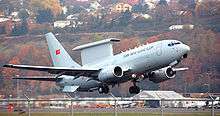
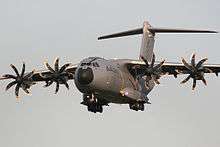
.jpg)
